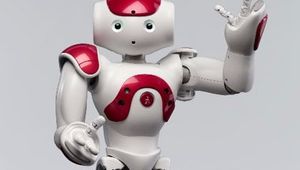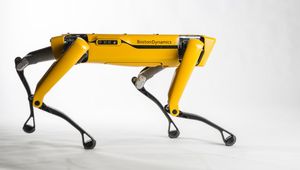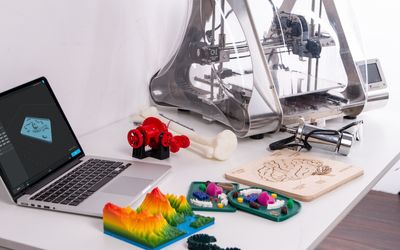AMTEx: Additive Manufacturing via Tube Extrusion
A method prints hollow tubes to reduce material use & print time for large-scale 3D prints
Technical Specifications
| Polymer used | PLA |
| Hollow Mandrel | Outer diameter: 8mm |
| Inner diameter: 7mm | |
| Side Fan | Number: 2 |
| size: 50mm | |
| Radial fan | Number: 1 |
| Power: 12V 0.1A | |
| size: 40mm | |
| maximum static pressure: 52Pa | |
| Temperature | 185℃ |
| Extrusion rate | 130mm/min |
| Feed rate | 0.5mm/s |
| Volumetric flow rate | ~26mm3/s |
| Average tensile strength | 62 MPa |
| Average flexural strength | 69 MPa |
| Freeform Printing | Program: UR5’s teaching pendant |
| Control: Universal Robots UR5 robotic arm | |
| Layer-based printing | Program: RoboDK and Slic3r |
| Extrusion control: Pronterface |
Overview
This tech spec was submitted by Ruben Janse van Vuuren as part of the University Technology Exposure Program.
Problem / Solution
AMTEx is conceptualized to reduce the material cost and printing duration of 3D printing of large-scale objects. AMTEx’s method of extruding hollow tubes significantly reduces polymer use and printing times for creating large-scale components. The current method for printing large-scale 3D prints has its disadvantages. Fused Filament Fabrication (FFF) 3D printers are burdened with high material usage and a slow printing process.
Design
The custom extruder design of AMTEx is composed of four main components: the filament feeder, heater block, hollow mandrel, and a cooling system.
The design features two extruder motors and filament spools to produce a symmetrical polymer flow into the heater block. Filament meets inside the heater block for the melting process. Melted polymer flows around a hollow mandrel inside the nozzle, with an 8mm outer diameter and 7mm inner diameter, to form the tube shape extrudate. The space within the tube provides a route for air from a radial fan to enter for pressurization to maintain the tube shape. A measured volumetric flow rate of around 26mm3/s from the AMTEx extruder is about 2.5 times more than a standard 3D printer with a 0.4mm nozzle. An active air-cooling system is used to facilitate a faster extrusion rate. Two battery-powered 50mm fans located on the sides of the nozzle are used for part cooling of exiting polymer. The air flows through the fan ducts and directly onto the extrudate after exiting the nozzle.
Print Output
Tubed extrusion yields significantly increased surface area compared to the conventional methods. Since AMTEx produces outputs with a higher surface area, there is a decrease in the material usage and printing time to make the same output with the FFF technique. The convective heat transfer is also reduced to a minimum due to the tubed-shaped nature of the extrusion, thus allowing tubed extrusion to cool faster than rod-shaped extrusion.
The AMTEx tubes displayed an almost identical stiffness but higher strength and ductility when compared with traditionally printed FFF tubes. A vase was printed using AMTEx to examine its printing parameters, which matches the model geometry well. The printed vase has 8mm wide tubes and 4mm in height. However, a slightly irregular geometry was observed due to the dragging of the tube while printing, hence the need for improving the part cooling function. The vase product uses 60% less material compared to the same output using conventional methods.
Freeform Printing Feature
The rapid cooling feature of AMTEx allows for freeform extrusion. The extruded tubes can support themselves mid-air with minimal sagging. To fully demonstrate this ability, a Universal Robots UR5 robotic arm with its increased Degrees of Freedom (DOF) and UR5’s teaching pendant can combine with the AMTEx to produce freeform projects.
Nevertheless, layer-based printing is still possible with AMTEx, given a slight positive pressure inside the tube. Hence, the standard slicing software for toolpath creation and even attachment to the conventional cartesian 3D printer is also possible. Using RoboDK and Slic3r for layer-based printing and Pronterface for extrusion control is compatible with AMTEx.
References
A research paper describing the challenge, design, and outcome of the research
Recommended Specs
Continue Reading
Combining SLA 3D printing and soft lithography for fast, versatile, and accessible high-resolution fabrication of customised multiscale cell culture devices with complex designs
Taking advantage of low-cost, high-resolution desktop resin 3D printers combined with PDMS soft-lithography we have developed an optimised microfabrication pipeline capable of generating a wide variety of customisable devices for cell culture and tissue engineering in an easy, fast reproducible way








